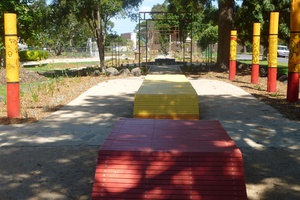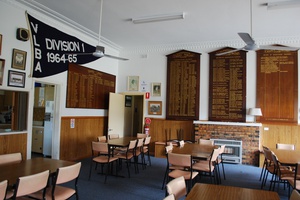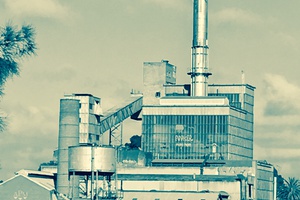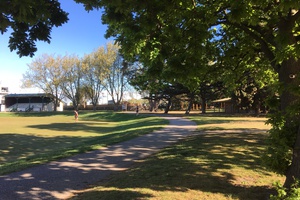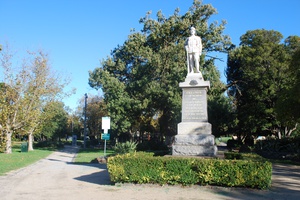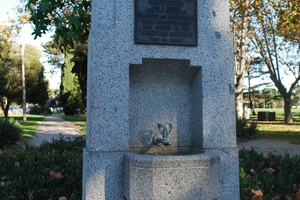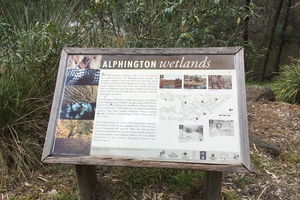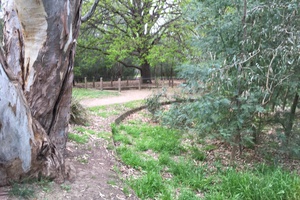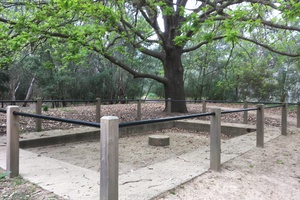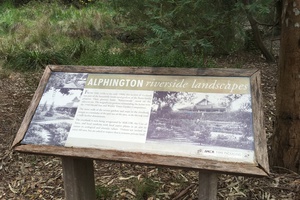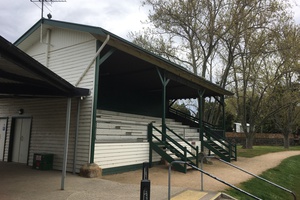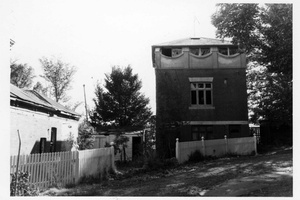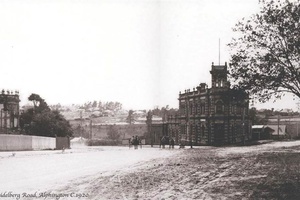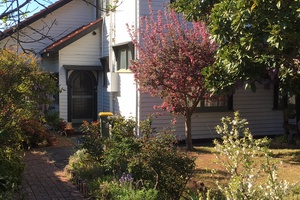This item is a part of these Tours
Alphington Park
Jump To TourThis record is a stop on a tour which goes to other places. Pick up the tour by jumping to it from here. Check the map to see where it goes. You can jump back to this place later.
This item is a part of these Themes
Sport and Recreation
Jump To ThemeThere are other records in this place with a similar theme. Explore this theme by jumping to it from here. You can jump back to this piece later.
Other content from this author
-
Alphington Bowls Club and Gates
Many bowling clubs built in the 1930s to 1960s in Australian suburbs have elaborate gates to mark their entrances, and often include commemorative plaques to war service and remembrance. Alphington’s ironwork that spells out “ABC” is typical of these kinds of commemorative gates and entrances.
HannahL
-
Alphington Park new gardens
A new ornate garden was designed for the northern perimeter of Alphington Park, in 2011-2012. The design caused some controversy with a number of local residents, and some elements of the six themed garden areas that each represent different aspects of Australian cultural and natural landscapes were modified. The skate ramp-seat painted red, yellow and black was removed due to some expressions of public dissatisfaction, and a series of totem poles with aboriginal motifs created by local school children and an artist were relocated to the playground area.
HannahL
-
Alphington Bowls Club
The Alphington Bowls Club was founded in 1921, and the ladies club in 1928. According to their club website they have been a very successful local club over many years and fielded an Australian team in 1923. For further details on the history of the “ABC”, see http://www.alphingtonbowlsclub.org.au/history.html The interior of the clubrooms is a wonderful time capsule, and is an important and enduring community space.
HannahL
-
Alphington Paper Mills
The Alphington Paper Mills Boiler House building is one of the larger buildings on the former Alphington Paper Mills / AMCOR site. The Boiler House, designed by Mussen, Mackay and Potter architects, was completed in 1954 and is thought to be one of the earliest known examples of “curtain wall” construction (a structure defined by metal framing and in-fill glass) in the state. The building has been a site of controversy over recent years as it was nominated for state heritage listing and protection and suggested re-use, however this recommendation was overturned in 2017, and the Boiler House is slated for demolition. The entire site is currently being redeveloped as a new suburb comprising of around 2500 homes and amenities. https://architectureau.com/articles/architecturally-significant-power-station-to-be-demolished-replaced-with-housing-development/
HannahL
-
Alphington Park
The suburb of Alphington was established along the Yarra River and a train-line connecting the centre of Melbourne to the eastern region of Heidelberg – known pejoratively in early years as the tediously slow line from “nowhere to nowhere”. The suburb was largely built in the extraordinary land boom years of the 1880s that gave rise to the label “Marvelous Melbourne”, when large areas of land were bought by private developers, subdivided and sold for private housing. The construction of ‘gentleman’s residences’ nearby to Alphington Park catered for the relatively affluent families, and some significant arts and crafts style bungalows remain in streets bordering the park today. The large paper mill site adjacent to the park reserve was first established in 1919, and it became the largest industrial complex in the district.
HannahL
-
World War I Memorial
The land that now comprises Alphington Park was originally donated to the community by local residents who saw the proximity to the river as a popular drawcard. It soon become a popular destination as a recreation and swimming area once it was connected to the railway. In 1921 it was chosen as the location for the building of a local memorial to World War I. Local residents raised funding by public subscription, the selling of lapel badges, fancy dress parades, and the hosting of a carnival staged in Alphington Reserve in 1921. The monument, a marble statue of an Australian ‘Digger' soldier, stands in the park as a symbolic commemoration of war service and sacrifice of men who lived in the area (25 who lost their lives and 75 who served). As is customary with such soldier statues, the digger wears the distinctively Australian uniform with slouch hat. He is clean-shaven and stands looking forward with his rifle at ease by his side. The memorial statue is set in a small ornamental garden of hedged rosemary, symbolic of remembrance.
HannahL
-
World War II Memorial
Next to the World War I statue in Alphington Park is a streamlined, granite memorial drinking fountain erected by local citizens after World War II. More modest and anonymous than the World War I statue, here there is no room for the inscription of personal names of those who served – just a plaque recording the dedication of the fountain and adjacent playground. These kinds of more ‘useful’ memorial structures and recreation facilities become more common in suburbs across Melbourne after WWII.
HannahL
-
Alphington Wetlands
As the sign here states, ‘Before European settlement, this area was the home of the traditional owners, the Wurundjeri-willam people. The floodplain adjacent to the Yarra rive was extensively cleared for farming and little of the bush remains.’ Keep reading the trail signs in this area of the park for more information.
HannahL
-
Alphington Swimming Pool in the Yarra
The Alphington Pool was located here on the banks of the Yarra River. It was constructed through voluntary community labour in the 1920s, to provide a safe entry point into the river and a local amenity to cater for the growing popularity of rowing, swimming and canoeing. The initial pool basin was later shaped into a more regular pool and lined with reinforced concrete, stones and brick, and terracing added for spectators, 2 diving boards and a 25-yard barrier for swimming lessons, dressing sheds.
HannahL
-
Alphington Swimming Pool – children’s wading pool
This smaller rectangular enclosure was constructed in the 1940s as a children’s shallow wading pool. The river pools had a great tendency to silt up, and due to the perceived health risks and increased car ownership that added to the decline in popularity of local facilities, places like this fell into disrepair in the 1950s. See also: Brown, R. The Story of the Alphington Swimming Pool. City of Yarra: SAFCA 2002.
HannahL
-
Runnymeade Residence and Gardens
Read the sign about the former Runnymeade house and gardens that once stood by the river on this part of the park.
HannahL
-
Kevin Crehan Grandstand and Alphington Park Oval
The oval has long been home to local sporting clubs and is used and loved by the local community and Alphington Primary School. This grandstand was built in 1950 – have a look at the plaque commemorating Kevin Crehan.
HannahL
-
Tower Hotel Alphington
The Tower Hotel was built at the corner of Heidelberg and Old Heidelberg Road in 1891.
HannahL
-
Lucerne Crescent House
The house at 54 Lucerne Crescent was designed by the well known architect Harold Desbrowe Annear and is of local historical and architectural significance. It has historical associations with the prominent artist William Mclnnes, for whom the house was built. And it is one of a number of houses designed by Desbrowe Annear in the Alphington / Heidelberg area.
HannahL

